The Far Cry games ranked from worst to best
We strap on a wingsuit and fly through the peaks and valleys of this open world FPS series.
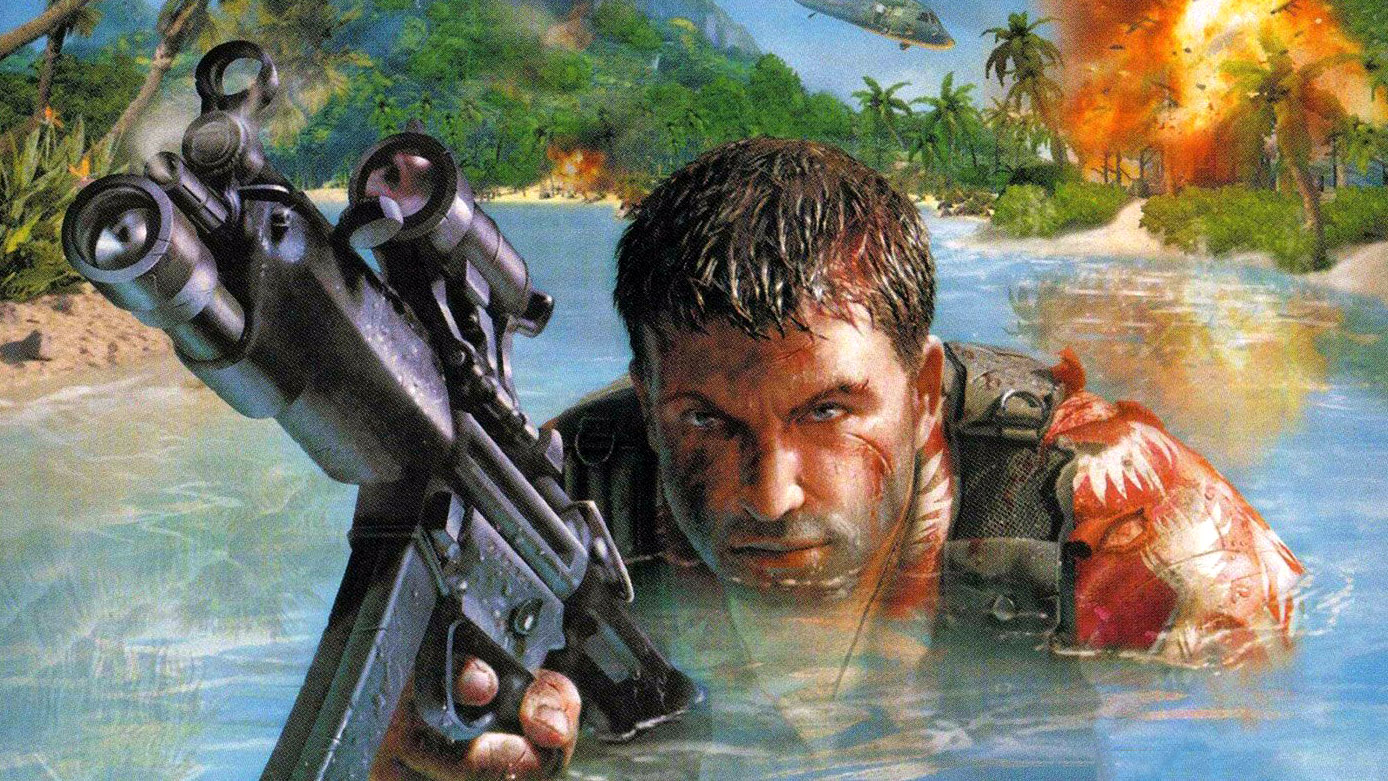
Ranking the games in the Far Cry series isn't an especially easy task given that for the most part it's been a widely varied collection of shooters: Far Cry 1, 2, and 3 were all distinctly different from one another, and while Far Cry 4, Far Cry 5, and Blood Dragon were quite similar to Far Cry 3, Primal threw us a curve and plopped us in the Stone Age. Another issue with ranking them: the Far Cry games are all pretty good! There are no stinkers in the series, meaning there's no one to really dump on. This makes things harder.
But just because something isn't easy doesn't mean it shouldn't be done. Below we've cobbled together a highly-unscientific ranking of the Far Cry series (sans Instincts, which only appeared on console). As with all of our rankings, this list is iron-clad and inarguable, so we expect nothing but collective head-nods of sycophantic agreement in the comments.
Here they are, the Far Cry games listed from worst to first.
Far Cry 3: Blood Dragon
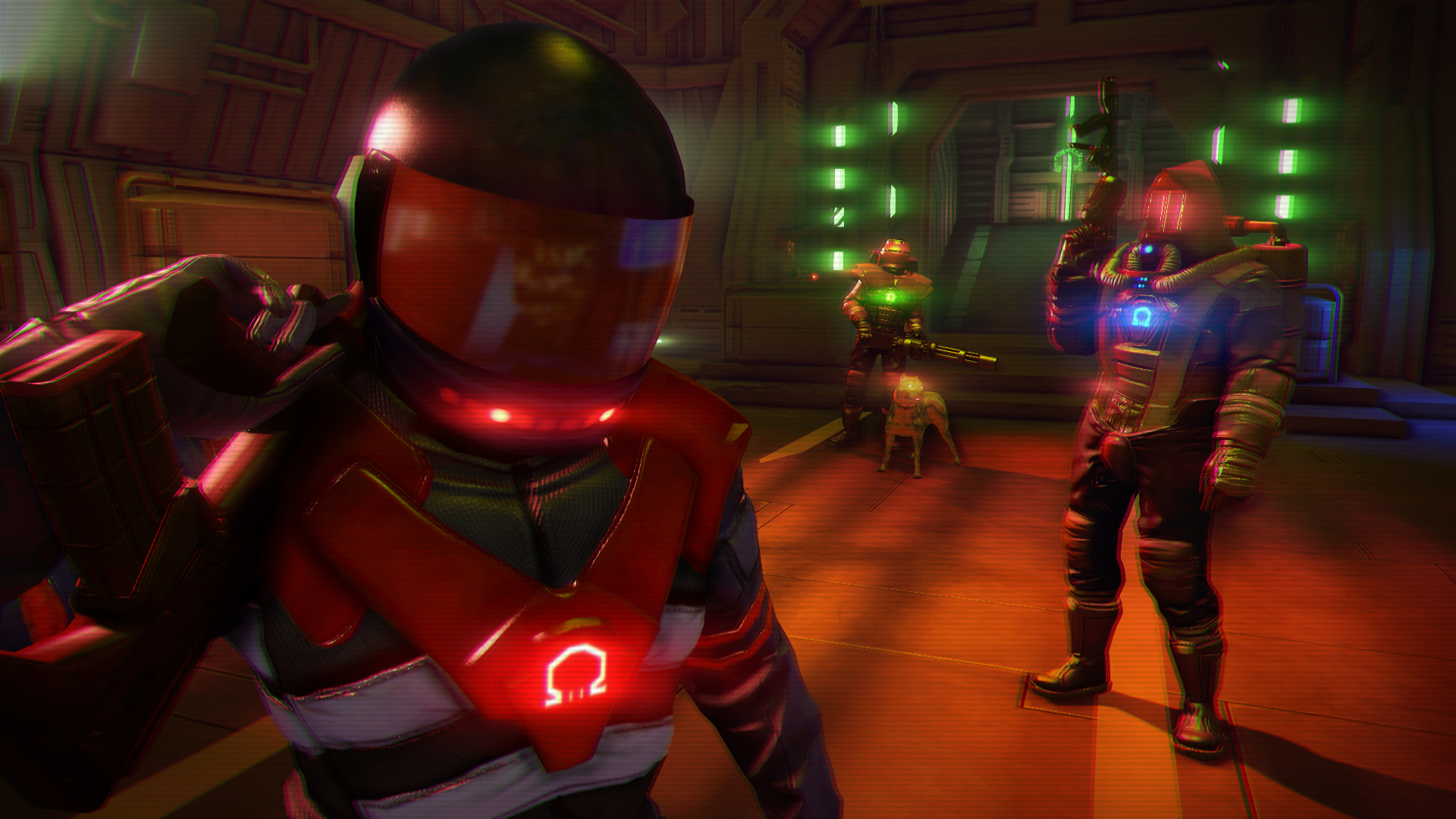
Developed: Ubisoft Published: Ubisoft
2013
Samuel: Blood Dragon is a pleasingly concentrated and beautiful slice of Far Cry 3, wrapped in a joke that maybe wears a bit too thin. It essentially offers everything the main game does, but in a sillier and more explosive framework, designed as it is to poke fun at '80s movies and games in general—the latter of which is a contentious point for some.
But it's so clearly enjoyable for what it is. Neon versions of Far Cry 3's creatures wander the landscape, and it's refreshingly streamlined, with no crafting and simpler progression systems. Throw a cyber heart to lure a Blood Dragon, watch the beast turn up to wreak some havoc, then move onto the next outpost. If the 20+ hours of game waiting in Far Cry 3 or 4 seems daunting, this is a pleasingly complete microcosm of the Far Cry experience.
Far Cry Primal
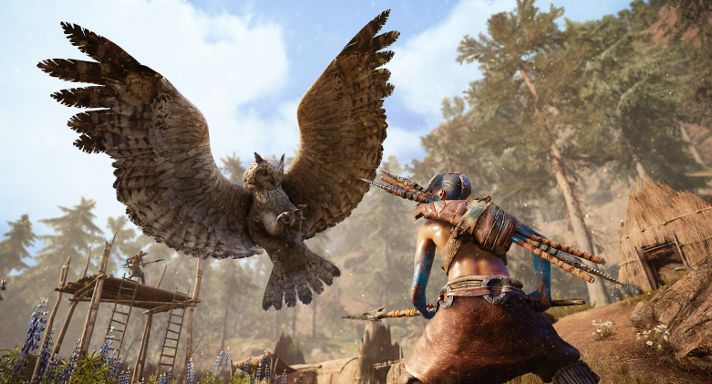
Developed: Ubisoft Published: Ubisoft
2016
Keep up to date with the most important stories and the best deals, as picked by the PC Gamer team.
Chris: Cranking back the clock—way back, to 10,000 BC—would seem a good way to take the series in an entirely new direction. There are no guns in Primal, of course. No cars, no aircraft, and absolutely no radio towers (thankfully). In some ways, it's pretty amazing that the familiar gameplay of Far Cry fits so well in an environment without automatic weapons and off-road vehicles.
The flip side is that Primal feels too familiar to really stand out. Stone Age or not, it's still unmistakably a Far Cry game and never really feels like a fresh experience. The ability to tame animals to fight alongside you is new, and while combat restricts you to bows, clubs, and spears (there is, enjoyably, a bee-filled pouch that acts as a grenade), the hunting and crafting you spend much of your time doing isn't any sort of departure from the series. Despite sending you thousands of years into the past, Primal winds up feeling a little too similar to Far Cry 3 and 4.
Far Cry 5

Developed: Ubisoft Published: Ubisoft
2018
Chris: Far Cry 5 is built on the foundation of 3 and 4 with only a few tweaks on the established formula. The small changes are welcome, though: there's no skill tree, so you can unlock perks in any order you want, giving you the freedom to build your character to fit your playstyle. The crafting system of the earlier games has been trimmed down, too, so you unlock additional weapon slots and ammo bags through perks instead of having to hunt specific animals. Far Cry 5 wants you to get into the beautiful and chaotic open world of Montana with as few roadblocks as possible.
But flying in the face of all the freedom you're given is the unpleasant habit the game's bosses have for kidnapping you. They'll routinely drag you from your open world adventures and force you to listen to their long, rambling monologues. Worse, the villains are bland and forgettable, with gimmicky battles required to beat them.
Far Cry 5 is still a fun and ridiculous sandbox of mayhem and destruction, but better bosses, and better writing, could have given it a higher ranking on our list.
Far Cry 2
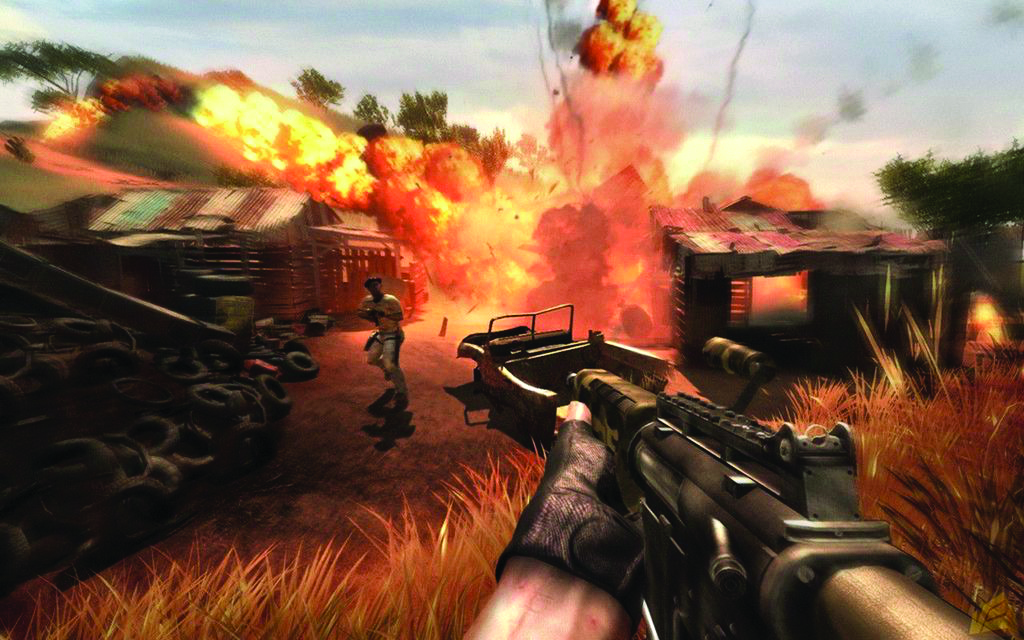
Developed: Ubisoft Published: Ubisoft
2008
Chris: Far Cry 2 is the favorite of several of the PC Gamer staff, but favorite doesn't automatically mean best*, and loving something doesn't mean you need to be blind to its flaws. From crippling you with malaria before you even manage to escape the intro, to restricting your sprinting to a few steps before running out of stamina, to roadside checkpoints that repopulate with suicidal bad guys the moment you glance in another direction, traveling the map can quickly become an exhausting and frustrating affair.
Making up for that, however, is everything else. The location, a sun-scorched province in Africa, is one of the most convincing environments a shooter has ever visited. The fire system is still fantastic, better even than the ones in later games, where flames spread through dry grass, up into trees, and across buildings, useful for flushing out and trapping enemies, but also often requiring the player to scramble to safety. The story is refreshingly nihilistic and bleak, the sprawling map leads into another, bigger one halfway through the game, and the gunplay (provided you're using guns you bought, as the ones you pick up off the ground are garbage) is fantastic.
*Note: I do really think it's the best, but we held a staff vote and I'll abide by the results.
Samuel: I appreciate the ambition of the story and the presentation of the world, though it's not particularly enjoyable next to the more recent games. I know that's an unpopular answer: Far Cry 2 is a favourite among game design academics, and fair enough. But sometimes you want to ride an elephant into a base, and that's okay.
I too appreciate Far Cry 2's fire and buddy system. Another touch I love about this game, that I assume Firewatch later borrowed, was the idea of the map being an object you hold in your hand. I haven't played the game in years, but I'll always remember that as a clever way of heightening the reality of that world.
Far Cry 3
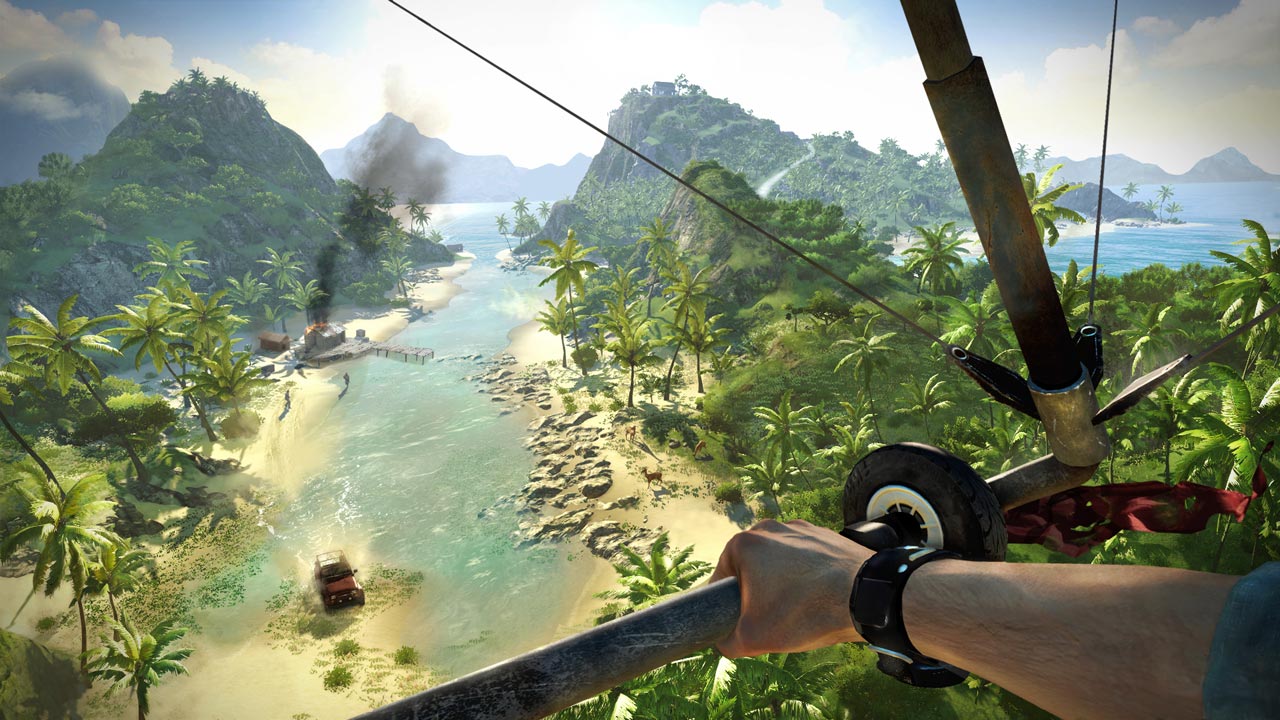
Developed: Ubisoft Published: Ubisoft
2012
Chris: Rather than casting you as an ex-Green Beret or hired merc, Far Cry 3's Jason Brody was supposed to be just some random bro who finds himself in way over his head. Naturally, you're still completely capable of killing hundreds of people, flying wingsuits around, and doing everything else the trained killers from the previous games could, but for at least an hour or two Brody yammers on about how he's just a bro who doesn't know what he's doing. It's not especially convincing.
This game also served as Far Cry's dive into crafting, which was largely baffling: having to hunt multiple animals to make a wallet that could hold more money, for instance. Far Cry 3's animals are much more fun when they're the ones doing the hunting, leaping out of the jungle to attack goons and rebels alike, who are often already in the process of attacking one another. The whole island is like a explosive set of dominos, where tipping one leaves a chaotic mess in its wake. There are times when just watching the carnage is as enjoyable as participating in it.
Luckily, you can break from the extended and often not-great story missions (you're trying to rescue your friends and repair the boat to escape, despite having access to lots of working boats, but whatever) and do whatever the heck you want. And, it solved one of the big issues with Far Cry 2: once you took over an outpost, it was yours. Enemies didn't repopulate, and they certainly didn't repopulate the moment you drove off-screen.
Tim: My memory is so shot to pieces now that the two main things I recall about Far Cry 3 are that 1) it was my favourite Far Cry, largely because it ditched the whole "having malaria as a gameplay mechanic" thing, and 2) what I loved most about the game was its signature weapons. For some reason I found collecting each of these—from the meaty Bull shotgun to the deranged Shredder SMG—absolutely compelling.
Unlocking them required an arduous amount of macguffin collection (this being a game that routinely tasks you with skinning 10 mongeese to craft a new wallet), but the chase for these white whale weapons was what drove me to keep going. Once I had them all my interest flamed out fast. An itch/scratch relationship I recognise only too well from my exotic weapon collection in Destiny. Actually, the other thing I remember about Far Cry 3 is that it genuinely felt like going on holiday. A ridiculous, action movie holiday accompanied by assholes, but a sunshine break nonetheless.
Far Cry
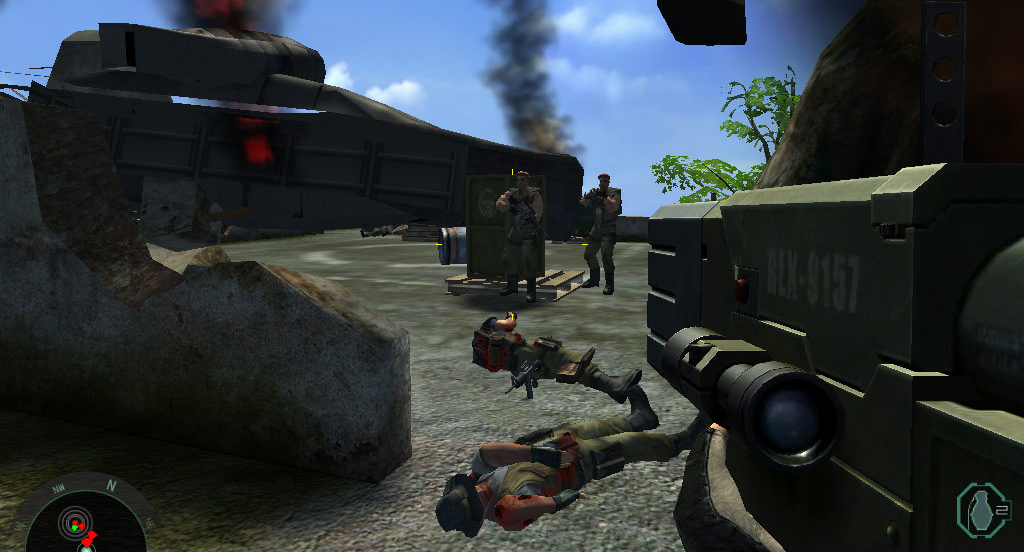
Developed: Crytek Published: Ubisoft
2004
Chris: It's hard to say how the original Far Cry holds up after a decade—we haven't played it in nearly that long—but at its release it was almost shockingly good. While it demanded a lot of our hardware at the time (it was a Crytek game, after all), it at least had some flexibility in graphical settings and still looked pretty great even on mid-range PCs.
James: The original Far Cry stood out for its massive open environments and the aggressive AI soldiers within. Firefights didn’t take place in a tightly scripted series of corridors—thick vegetation and a rudimentary stealth system turned encounters into an improvisational game of cat and cat and cat and cat and mouse (you). A few hours in, monsters get thrown into the jungle combat stew, and suddenly the enemy mercs are no longer sitting comfortably at the top of the food chain—not that they’re eating the monsters or you, I hope. Luring men to monsters and then hiding in a bush became the new headshot, an early push towards testing more skills than how quickly a player can point and click.
By today’s standards, Far Cry’s take on sneaky open arena combat feels noticeably dated, with enemies that have acute senses and preternatural aim anyone would envy. This is also before the era of elaborate back-stab animations, so stealth takes more patience and guesswork than it should, but even so, it’s easy to appreciate Far Cry for its obvious influence on open-ended island-hopping FPS design.
Far Cry 4
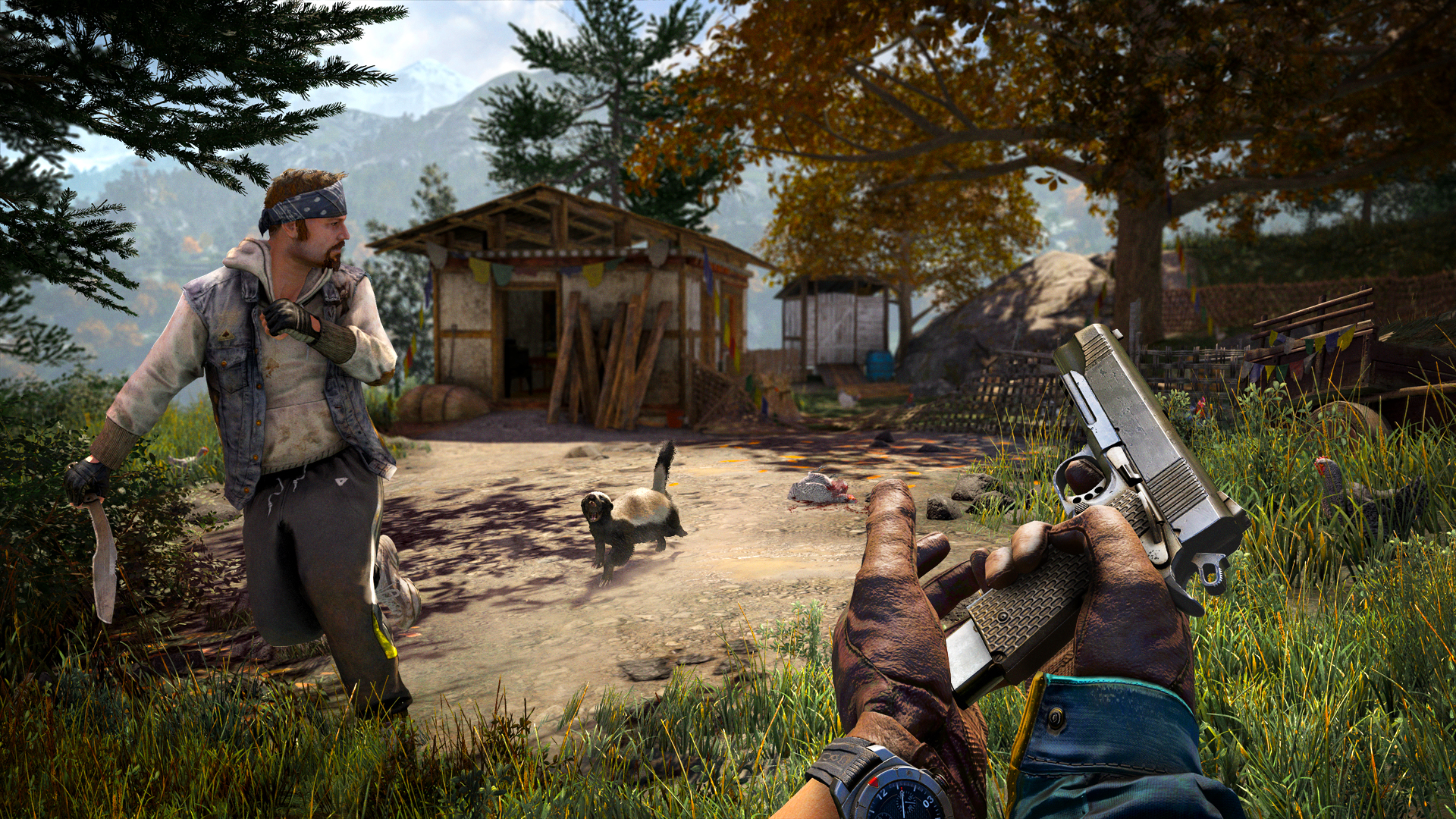
Developed: Ubisoft Published: Ubisoft
2014
Chris: For a series that had been reinventing itself with each release—Far Cry 1, 2, and 3 were all markedly different from one another—Far Cry 4 was a noticeable departure. It built on the gameplay of the previous entry without completely reimagining it. Coming just two years after Far Cry 3, Far Cry 4 felt incredibly familiar, but the changes it did bring were all for the better.
Rather than the overly vocal Jason Brody, protagonist Ajay Ghale is more subdued and quiet, letting the player fill in the blanks of his personality. Instead of simple bad luck stranding him among scores of warring soldiers and freedom fighters, Ajay has a real reason for being in the region of Kyrat: he's returned to scatter his mother's ashes, and the region's rebels are a military group founded by his father. What's more, Pagan Min, the colorful and charismatic baddie, once had an affair with Ajay's mother, making Ajay's appearance in Kyrat a personal one in several respects.
Kyrat itself is a wonderful and chaotic playground, sprawling and mountainous and with plenty of new ways to get around in it, like gyrocopters and a grappling hook, plus the familiar wingsuit that this time can be accessed almost immediately. The insanely aggressive wildlife makes a return, allowing us to unleash them on unsuspecting enemies and providing no small amount of random, ridiculous carnage. Plus, you can ride elephants, bowling over vehicles and tossing enemies into the air.
Alongside the scripted story missions, outpost takeovers once again comprise the most enjoyable part of the game, freeform assaults that can be accomplished any way you like. Outposts are bolstered by the addition of strongholds: massive and well-protected forts that are even tougher and more fun to liberate. This being a Ubisoft game, the map is littered with all sorts of other activities, challenges, and points of interest. They don't all really add much but, but they do ensure there's something to do just about everywhere you roam. Throw in co-op (except for story missions) and Far Cry 4 is a heavily packed and gloriously fun sandbox of destruction.

Chris started playing PC games in the 1980s, started writing about them in the early 2000s, and (finally) started getting paid to write about them in the late 2000s. Following a few years as a regular freelancer, PC Gamer hired him in 2014, probably so he'd stop emailing them asking for more work. Chris has a love-hate relationship with survival games and an unhealthy fascination with the inner lives of NPCs. He's also a fan of offbeat simulation games, mods, and ignoring storylines in RPGs so he can make up his own.
- James Davenport
- Samuel Roberts
- Phil SavageEditor-in-Chief

